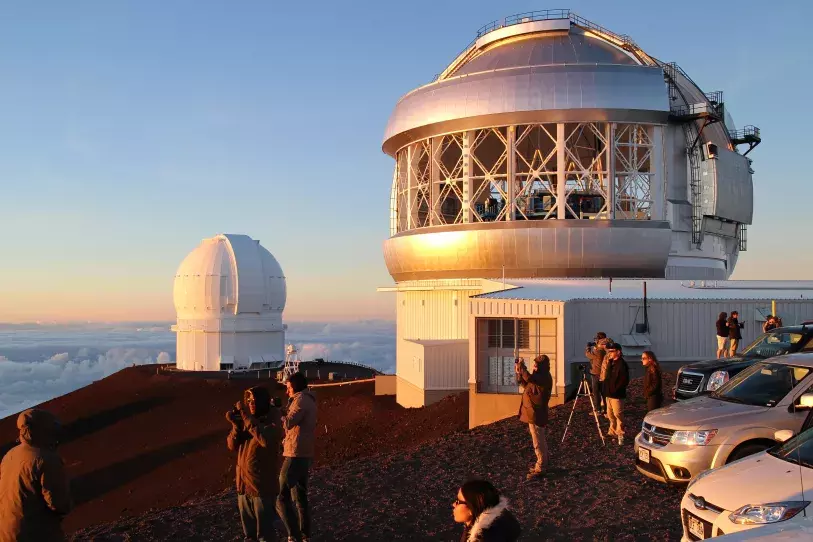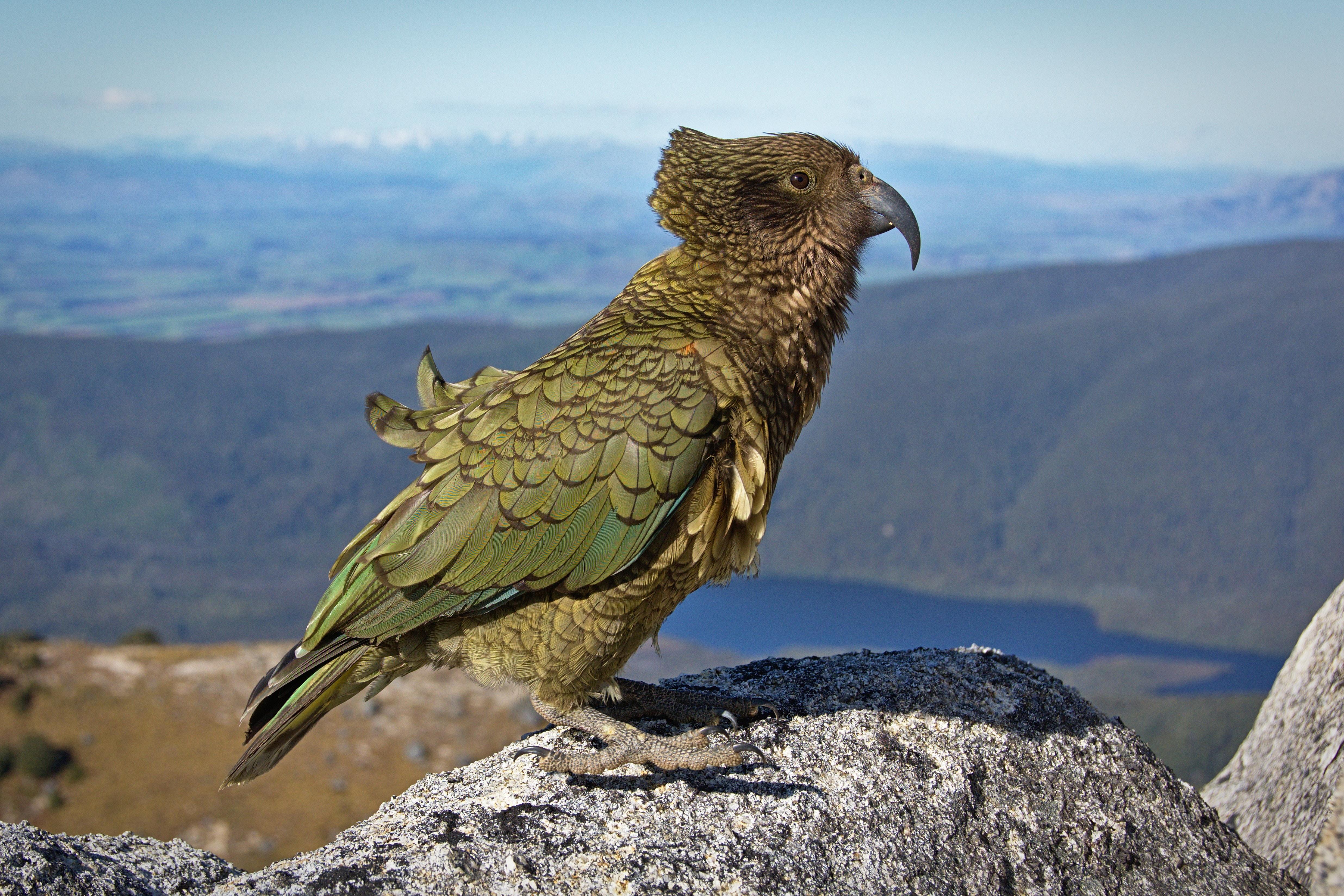Error message

By Abby G. Frazier and Laura Brewington
HONOLULU (November 11, 2019)—Of all the earth’s environments, alpine regions are arguably the most vulnerable to climate change. This is especially true for alpine areas on islands. Island ecosystems are also particularly vulnerable to damage from human activity and the invasion of alien species due to their isolated and limited land areas.
In the Pacific Ocean, islands range from small, low-lying coral atolls to large islands with volcanic peaks higher than 12,000 feet, high enough to contain alpine areas. In both Hawai‘i and New Zealand, about 11 percent of the land area is above the tree line, the definition of an alpine environment. In both places, these high-altitude regions have significant biological, cultural, and economic value.
From the biological perspective, an unusually large proportion of the plants and animals found in the alpine areas of Hawai‘i and New Zealand are endemic—meaning that they are found in no other place on the planet. If threatened in their native habitats, these species are vulnerable to extinction.
Culturally, the mountains of New Zealand are immensely important to the Maori way of life and sense of place, with individual peaks seen as representations of ancestors. Native Hawaiian tradition states that deities reside in high mountains, and summit areas on Maui and the Big Island of Hawai‘i are regarded as sacred.
Alpine areas also have important economic value. In New Zealand, hiking, hunting, fishing, skiing, and snowboarding draw tourists to many of the country’s high-elevation parks. Overall, New Zealand’s nature tourism industry generates about 6 percent of the country’s Gross Domestic Product (GDP), second only to the dairy industry. In Hawai‘i, Haleakala National Park on Maui is visited by more than one million people each year. The construction and operation of astronomical observatories—particularly those near the summit of Mauna Kea on the Island of Hawai‘i—provide significant scientific and economic value, although they have been contentious for decades due to their impacts on native ecosystems and cultural sites. Today, these areas are threatened by three independent but interacting forces: climate change, the invasion of exotic species, and disturbance by human activity.
Global warming hits alpine areas particularly hard
Both Hawai‘i and New Zealand have experienced strong warming at high elevations. Thirty-four percent of the ice volume in New Zealand’s Southern Alps has been lost since 1977. In Hawai‘i, loss of cloud cover has exposed the mountains to high levels of solar radiation, resulting in significant drying. Confined to small areas and surrounded by ocean, native alpine plants and animals whose environments are threatened have no place to go, and some endemic species risk being lost forever.

Future projections indicate that today’s strong warming trends will continue, with the largest increases in temperature occurring at the highest elevations. Models forecast that New Zealand may lose 88 percent of its total ice volume by 2100. Over the same 80-year period, snowfall on Hawai‘i’s mountain peaks is projected to almost entirely disappear.
In addition to the steady loss of ice and snowfall, alpine ecosystems are subject to soil erosion and landslides associated with short-term temperature extremes. These changes in high-altitude areas can affect land and water resources in adjacent lowland areas right out to the ocean’s edge.
Human activities and invasive species also take their toll
Apart from global warming, changes in high-elevation ecosystems can be driven by numerous other factors, including overgrazing by livestock, environmental stress from recreational and other human activities, and invasion by alien species. All of these factors have had an impact on alpine environments in Hawai‘i and New Zealand.
Historically, the harsh climate and limited human intrusions have protected alpine environments from degradation and the introduction of alien plants and animals. Today, however, warming temperatures and increased human activity are weakening these protections.
In several alpine areas of New Zealand, grazing livestock have introduced invasive herbs, threatening native grasslands. In some places, feral populations of red deer, Himalayan tahr, and rabbits have reduced native tussock plants to bare ground. New Zealand’s ground-dwelling native alpine birds are particularly susceptible to predation by introduced stoats, mice, and feral cats.
Invasive pigs, cattle, and goats have severely damaged Hawaiian alpine ecosystems, coinciding with soil erosion and the invasion of exotic plants. Invasive grasses on Mauna Kea increase wildfire risk, threatening the last remaining habitats of endangered bird populations. Invasive pine trees in both Hawai‘i and New Zealand outcompete native tree species and reduce water yields in adjacent lowland areas.
In Hawai‘i, tourists visiting Haleakala National Park, Mauna Kea, and Mauna Loa have brought alien plant seeds, pathogens, and insects. In New Zealand, backcountry huts used by tourists play an important role in the introduction of invasive plants into remote alpine areas.
More information for better management
Alpine ecosystems are complex and not fully understood—particularly alpine ecosystems on small islands—but they are arguably, of anywhere in the world, the places most affected by climate change. In addition to warming, patterns of rainfall, wind, and snow cover are changing in complex ways, as are human disturbances and the impacts of invasive species. Much is still unknown about the responses of native plants and animals to these changes. Resource managers are challenged to accommodate multiple-use natural areas—combining conservation with winter sports, hunting, tourism, and cultural use—while monitoring and managing for ecosystem change.
The good news is that monitoring efforts are improving. The Haleakala Climate Network (HaleNet), established in 1988, monitors 13 climate variables at eight high-altitude stations in Haleakala National Park. The 30-plus years of information gathered here provide an invaluable dataset for the State of Hawai‘i. In New Zealand, two field sites in the Southern Alps were recently incorporated into the Global Observation Research Initiative in Alpine Environments (GLORIA) project, which was founded in 2001 to monitor vegetation and climate in high-elevation regions around the world.
These efforts are welcome, but the need for additional monitoring and research is clear. The alpine ecosystems of the Pacific Islands are rare, isolated both by elevation and by the surrounding ocean, and they are uniquely sensitive to the threats posed by human activities, introduced species, and climate change. Much remains to be done to protect and preserve them.
###
Abby G. Frazier and Laura Brewington are both Fellows at the East-West Center. Dr Frazier can be reached at [email protected]. Dr. Brewington can be reached at [email protected].
Download a pdf version of this Wire article.
The East-West Wire is a news, commentary, and analysis service provided by the East-West Center in Honolulu. All or any part of the Wire content may be used by media with attribution to the East-West Center or the person quoted. To receive Wire articles via email, subscribe here. For links to all East-West Center media programs, fellowships and services, see EastWestCenter.org/Journalists.
The full list of East-West Wires produced by the Research Program is available on the East-West Center website at EastWestCenter.org/Research-Wire. For more on the East-West Center Research Program, see EastWestCenter.org/Research.
The East-West Center promotes better relations and understanding among the people and nations of the United States, Asia, and the Pacific through cooperative study, research, and dialogue.
Series editors:
Derek Ferrar
[email protected]
Sidney B. Westley
[email protected]
The views expressed do not necessarily reflect the policy or position of the East-West Center or of any other organization.
Top Photo: Concern is growing about the impact of tourism and astronomical observatories on Mauna Kea in Hawai'i. Credit: Laura Brewington.
By Abby G. Frazier and Laura Brewington
HONOLULU (November 11, 2019)—Of all the earth’s environments, alpine regions are arguably the most vulnerable to climate change. This is especially true for alpine areas on islands. Island ecosystems are also particularly vulnerable to damage from human activity and the invasion of alien species due to their isolated and limited land areas.
In the Pacific Ocean, islands range from small, low-lying coral atolls to large islands with volcanic peaks higher than 12,000 feet, high enough to contain alpine areas. In both Hawai‘i and New Zealand, about 11 percent of the land area is above the tree line, the definition of an alpine environment. In both places, these high-altitude regions have significant biological, cultural, and economic value.
From the biological perspective, an unusually large proportion of the plants and animals found in the alpine areas of Hawai‘i and New Zealand are endemic—meaning that they are found in no other place on the planet. If threatened in their native habitats, these species are vulnerable to extinction.
Culturally, the mountains of New Zealand are immensely important to the Maori way of life and sense of place, with individual peaks seen as representations of ancestors. Native Hawaiian tradition states that deities reside in high mountains, and summit areas on Maui and the Big Island of Hawai‘i are regarded as sacred.
Alpine areas also have important economic value. In New Zealand, hiking, hunting, fishing, skiing, and snowboarding draw tourists to many of the country’s high-elevation parks. Overall, New Zealand’s nature tourism industry generates about 6 percent of the country’s Gross Domestic Product (GDP), second only to the dairy industry. In Hawai‘i, Haleakala National Park on Maui is visited by more than one million people each year. The construction and operation of astronomical observatories—particularly those near the summit of Mauna Kea on the Island of Hawai‘i—provide significant scientific and economic value, although they have been contentious for decades due to their impacts on native ecosystems and cultural sites. Today, these areas are threatened by three independent but interacting forces: climate change, the invasion of exotic species, and disturbance by human activity.
Global warming hits alpine areas particularly hard
Both Hawai‘i and New Zealand have experienced strong warming at high elevations. Thirty-four percent of the ice volume in New Zealand’s Southern Alps has been lost since 1977. In Hawai‘i, loss of cloud cover has exposed the mountains to high levels of solar radiation, resulting in significant drying. Confined to small areas and surrounded by ocean, native alpine plants and animals whose environments are threatened have no place to go, and some endemic species risk being lost forever.

Future projections indicate that today’s strong warming trends will continue, with the largest increases in temperature occurring at the highest elevations. Models forecast that New Zealand may lose 88 percent of its total ice volume by 2100. Over the same 80-year period, snowfall on Hawai‘i’s mountain peaks is projected to almost entirely disappear.
In addition to the steady loss of ice and snowfall, alpine ecosystems are subject to soil erosion and landslides associated with short-term temperature extremes. These changes in high-altitude areas can affect land and water resources in adjacent lowland areas right out to the ocean’s edge.
Human activities and invasive species also take their toll
Apart from global warming, changes in high-elevation ecosystems can be driven by numerous other factors, including overgrazing by livestock, environmental stress from recreational and other human activities, and invasion by alien species. All of these factors have had an impact on alpine environments in Hawai‘i and New Zealand.
Historically, the harsh climate and limited human intrusions have protected alpine environments from degradation and the introduction of alien plants and animals. Today, however, warming temperatures and increased human activity are weakening these protections.
In several alpine areas of New Zealand, grazing livestock have introduced invasive herbs, threatening native grasslands. In some places, feral populations of red deer, Himalayan tahr, and rabbits have reduced native tussock plants to bare ground. New Zealand’s ground-dwelling native alpine birds are particularly susceptible to predation by introduced stoats, mice, and feral cats.
Invasive pigs, cattle, and goats have severely damaged Hawaiian alpine ecosystems, coinciding with soil erosion and the invasion of exotic plants. Invasive grasses on Mauna Kea increase wildfire risk, threatening the last remaining habitats of endangered bird populations. Invasive pine trees in both Hawai‘i and New Zealand outcompete native tree species and reduce water yields in adjacent lowland areas.
In Hawai‘i, tourists visiting Haleakala National Park, Mauna Kea, and Mauna Loa have brought alien plant seeds, pathogens, and insects. In New Zealand, backcountry huts used by tourists play an important role in the introduction of invasive plants into remote alpine areas.
More information for better management
Alpine ecosystems are complex and not fully understood—particularly alpine ecosystems on small islands—but they are arguably, of anywhere in the world, the places most affected by climate change. In addition to warming, patterns of rainfall, wind, and snow cover are changing in complex ways, as are human disturbances and the impacts of invasive species. Much is still unknown about the responses of native plants and animals to these changes. Resource managers are challenged to accommodate multiple-use natural areas—combining conservation with winter sports, hunting, tourism, and cultural use—while monitoring and managing for ecosystem change.
The good news is that monitoring efforts are improving. The Haleakala Climate Network (HaleNet), established in 1988, monitors 13 climate variables at eight high-altitude stations in Haleakala National Park. The 30-plus years of information gathered here provide an invaluable dataset for the State of Hawai‘i. In New Zealand, two field sites in the Southern Alps were recently incorporated into the Global Observation Research Initiative in Alpine Environments (GLORIA) project, which was founded in 2001 to monitor vegetation and climate in high-elevation regions around the world.
These efforts are welcome, but the need for additional monitoring and research is clear. The alpine ecosystems of the Pacific Islands are rare, isolated both by elevation and by the surrounding ocean, and they are uniquely sensitive to the threats posed by human activities, introduced species, and climate change. Much remains to be done to protect and preserve them.
###
Abby G. Frazier and Laura Brewington are both Fellows at the East-West Center. Dr Frazier can be reached at [email protected]. Dr. Brewington can be reached at [email protected].
Download a pdf version of this Wire article.
The East-West Wire is a news, commentary, and analysis service provided by the East-West Center in Honolulu. All or any part of the Wire content may be used by media with attribution to the East-West Center or the person quoted. To receive Wire articles via email, subscribe here. For links to all East-West Center media programs, fellowships and services, see EastWestCenter.org/Journalists.
The full list of East-West Wires produced by the Research Program is available on the East-West Center website at EastWestCenter.org/Research-Wire. For more on the East-West Center Research Program, see EastWestCenter.org/Research.
The East-West Center promotes better relations and understanding among the people and nations of the United States, Asia, and the Pacific through cooperative study, research, and dialogue.
Series editors:
Derek Ferrar
[email protected]
Sidney B. Westley
[email protected]
The views expressed do not necessarily reflect the policy or position of the East-West Center or of any other organization.
Top Photo: Concern is growing about the impact of tourism and astronomical observatories on Mauna Kea in Hawai'i. Credit: Laura Brewington.
East-West Wire
News, Commentary, and Analysis
The East-West Wire is a news, commentary, and analysis service provided by the East-West Center in Honolulu. Any part or all of the Wire content may be used by media with attribution to the East-West Center or the person quoted. To receive East-West Center Wire media releases via email, subscribe here.
For links to all East-West Center media programs, fellowships and services, see www.eastwestcenter.org/journalists.







